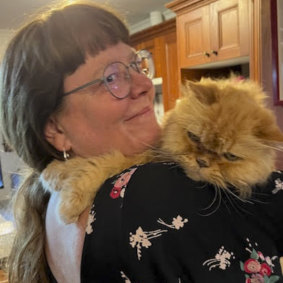
“I have generalised anxiety disorder and he’s an angel,” she said. “Running my fingers through his fur and his smell gives me a lot of comfort.”
Arnold is not the only pet owner who wants and expects more for their animals, said a spokeswoman for pet supplies retailer Pet O.
“It’s not surprising considering that pets are a big part of the family,” she said. “So it’s only natural to want to give them the right nutrition, the best vet care, premium toys and treats and adventures to ensure they are living a fulfilled life.”
Jo Lusk has a 16-year-old Persian, Mr Bits, who has a heart condition that requires daily medication.

Jo Lusk said she is “completely dedicated and in love” with her 16-year-old Persian Mr Bits.Credit: Jo Lusk
“He has had several cardiologists attending to his care over the years as well as a general vet and is currently on four-to-five pills twice daily,” she said.
Lusk spent $5000 on vet visits last year including a stay in intensive care as well as $2200 in medications and $1600 on boarding.
“Despite the costs, I am completely dedicated and in love with this little man,” she said. “He is an amazing patient and has survived all the odds, especially this last year. He brings me joy and makes me laugh every day and has many fans.”
A Greencross Pet Wellness Company spokeswoman said the trend of humanising pets meant owners placed as much importance on their pet’s health and wellbeing as their own.
She said owners wanted to feed pets the same types of ingredients they want in their own foods, while pet clothing and accessories were influenced by trends in children’s fashion or baby toys.
“Calendar events like Christmas, birthdays and Halloween are also becoming bigger and bigger as more owners look for ways to get their pets involved in the festivities through play, through treating or through dressing up,” she said.
Data from Greencross, which owns vet clinics as well as pet supply retailer Petbarn, shows two-thirds of Australians do not know how much their pets cost them each year and 58 per cent do not budget for their pet.
“Millennials and Gen Z are welcoming pets into their families faster than their parents did,” she said. “In a very short time, we have seen the family pet move from the backyard to the laundry to the bedroom.”
Pet supplies retailers generated more than $4.5 billion in yearly revenue in Australia, fuelled by high inflation and rising demand, with IBISWorld forecasting the sector to grow at an annual rate of 2.4 per cent over the next five years.
Loading
“Part of this growth in annual revenue is accounted for by higher prices, particularly over the last few years,” IBISWorld senior industry analyst Jack Fahey said.
“However, demand is also trending upwards, as the rate of ownership boomed during the pandemic, which is also feeding into higher prices for pet foods, medicines and accessories.”
Economic hardship and difficulties in renting properties for pet owners has resulted in a 30 per cent decline in pet adoptions from the RSPCA, and a 40 per cent increase in the average length of stay for adult dogs in its care compared to last year.
The cost of caring for a pet is one of the top reasons owners surrender their animals, with the NSW branch of the RSPCA receiving an average of 20 calls a day about surrendering pets, a spokeswoman said.
“Potential pet owners need to be prepared to pay for ongoing costs associated with food, worming, annual health checks, vet bills, training, care when you are away, toys and bedding, and more for the life of your animal,” she said.









 Add Category
Add Category